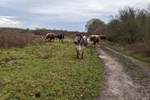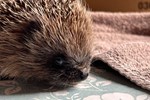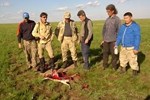Dr Stuart Patterson
Department: Pathobiology & Population Sciences
Campus: Hawkshead
Research Groups: Pathogen Flow in Ecosystems, IRLFS (Research Programme)
Stuart is our Senior Lecturer in Wild Animal Health and his current roles include being the pathway leader for the BSc/MSci Biological Sciences (Wildlife Health Sciences), and the tracking rotation leader for our final year veterianry students' zoo tracking programme. His main interests are in the relevance of disease processes to conservation, and how this changes as existing populations become more fragmented.
As Associate Dean for Postgraduate Teaching and Learning, Stuart has responsibility for overseeing our taught masters programmes (Veterinary Epidemiology, Wild Animal Biology, Wild Animal Health, One Health, and our Distance Learning programmes), as well as our postgraduate clinical training programmes (our PG DIP VCP, and our MVetMed).
Career
2021- Present Junior Vice President (1 year), President (1 year) and now Senior Vice President of the British Veterinary Zoological Society
2021- date Associate Dean for Postgraduate Teaching and Learning, RVC
2018-date Lecturer in Wild Animal Health, RVC (Senior Lecturer since 2021)
2018 - Present Pathway Leader for BSc Biological Science (Wildlife Health Sciences)
2018 – 2021 Course Director for MSc Wild Animal Biology and MSc Wild Animal Health
2017-2018 Temporary Lecturer in Dairy Medicine, RVC
2013-2017 PhD, RVC
2012-2013 Masters Student RVC
2007-2012 Veterinary surgeon working in UK farm animal practice
Qualifications
2020 PG Certificate in Veterinary Education, RVC
2017 PhD in Veterinary Epidemiology, RVC
2015 Master of Veterinary Science in Veterinary Conservation Medicine, University of Edinburgh
2013 Master of Science in Veterinary Epidemiology, RVC
2007 Bachelor of Veterinary Medicine, Royal Veterinary College London
My PhD work fieldwork was undertaken in the Kalahari desert of South Africa at the Kalahari Meerkat Project. Here I looked at targeting individuals for vaccination based upon their social position. I was interested in whether by targeting important individuals in the transmission network, disease levels could be controlled more efficinetly than with blanket vaccination.
6. Patterson, S.J. Clutton-Brock, T.H. Pfeiffer, D.U. and Drewe J.A. (2022) Trait-Based Vaccination of Individual Meerkats (Suricata suricatta) against Tuberculosis Provides Evidence to Support Targeted Disease Control. Animals https://doi.org/10.3390/ani12020192
7. Pereira, M. Stidworthy, M.F. Denk, D. Spiro, S. Guthrie, A. Patterson S. (2021) A retrospective study of morbidity and mortality identified at postmortem examination of captive langurs (Trachypithecus spp) from six United Kingdom zoological instituions: a 19 year review. Journal of Zoo and Wildlife Medicine 52 (4) 1123-1134 doi.org/10.1638/2021-0022
10. Patterson, S. Bond, K. Green, M. van Winden, S. and Guitian, J. (2019) Mycobacterium avium paratuberculosis infection of calves - The impact of dam infection status. Preventative Veterinary Medicine, doi.org/10.1016/j.prevetmed.2019.02.009
Stuart is currently the pathway leader for the BSc/MSci in Biological Sciences (Wildlife Health Sciences). As well as these courses he runs a Zoo Tracking rotation for the BVetMed students, and contributes to communication skills training on the veterinary course. At a modular level, Stuart runs a Biodiversity Action Plan Dissertation module for our third year undergraduate science studnts, and an Introduction to Wild Animal Biology in the second year.
-
Epidemiology of Tuberculosis in Meerkats of the Kalahari
Research project by the Royal Veterinary College investigating the epidemiology of Tuberculosis in meerkats in the Kalahari Desert in southern Africa.
Meerkats (Suricata suricatta) are social mammals that live in groups. A potential disadvantage of being social is that infectious diseases are more likely to spread. Tuberculosis (TB: a bacterial infection) was first detected in wild meerkats in southern Africa in the late 1990s.
-
Health of domesticated cattle in rewilding
Domesticated cattle are used in rewilding projects to utilise their ecological impacts upon these systems. Human expectations, and therefore health measures, of these animals differ from those of farmed livestock.
-
Investigating facial and limb abnormalities in European Hedgehogs (Erinaceus europaeus)
This project aims to describe the features and investigate the cause of a rare syndrome causing facial and limb abnormalities in European Hedgehogs (Erinaceus europaeus) across the UK and EU.
-
Saiga Mass Mortality: ongoing research on causes of mortality in saiga antelope in Kazakhstan and Mongolia
The saiga project is a long-term contribution from RVC to research into understanding of the causes of mortality of the saiga antelope. This species ranges in the Steppes of Asia, in a few localities but is classified as critically endangered by the International Union for Conservation of Nature red listing process. The study findings to date provided unique information on the cause of mass mortality of saiga and the impact of PPR on saiga antelope.




